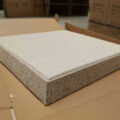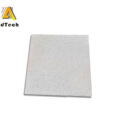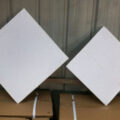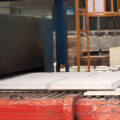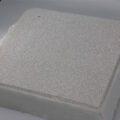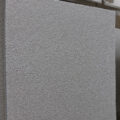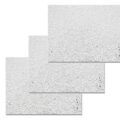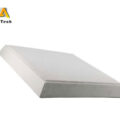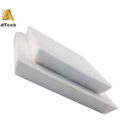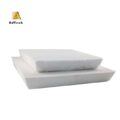Open-pore ceramic foam filters for use in aluminum cast houses were developed in the early 1970s with the first commercial application of the technology in 1974 to produce rolling ingots for fabrication into plate and sheet materials. Open-pore ceramic foam filters are monolithic, one-shot or disposable, filters that are used for a single cast. Filter pore size ranges from 4 to 28 pores per cm (10 to 70 pores per linear inch), which corresponds to pore with a diameter of about 0.036 to 0.26 cm. Ceramic foam filters are typically produced in square sizes ranging from 22.86 cm×22.86 cm×5.08 cm (9 in×9 in×2 in) to 66.04 cm×66.04 cm×5.08 cm (26 in×26 in×2 in).

On the bevel edge a fiber paper gasket is fixed to provide lateral compression loading to hold the filter in place in the CFF filter box and to prevent metal bypass around the edge of the filter. The fiber gasket material is typically about 0.317 cm to 0.476 cm (⅛ to 3/16″) thick and is typically comprised of silicate fibers. Vermiculite is oftentimes added to the gasket material, which expands during heating to increase the gasket pressure. Typical use time in the molten aluminum is 30 to 120 minutes.
The production of aluminum ingots and billets for fabrication into high-quality aluminum products requires that the molten aluminum be relatively free of inclusions such as insoluble solid or immiscible liquid impurities. This is to ensure that the ingots or billets after downstream fabrication will meet the stringent requirements of high-quality products such as rigid and flexible packaging materials, aerospace products (extrusions, sheet, plate, forgings), lithographic, automotive condenser tubing, and bright trim. During the production of the molten aluminum insoluble impurities or inclusions are generated throughout the entire reduction, holding, alloying, and casting processes.
In the primary electrolytic reduction process, un-dissolved alumina; aluminum carbides; sodium aluminum fluoride from the electrolytic bath, and γ-alumina skins are carried over as impurities and inclusions. In furnace holding and alloying stages magnesium aluminate spinet, magnesia, γ-alumina skins, and furnace refractories are generated as inclusions or impurities. In the metal transfer during casting chloride salts, titanium boride clusters, eroded refractories, and γ-alumina skins are generated as impurities or inclusions.
It is desirable to remove the inclusions in the last processing step prior to the molten aluminum being solidified into an ingot or billet through filtration. This has been done for many years in the industry through the use of a variety of technologies, including bed filtration and ceramic foam filtration.



